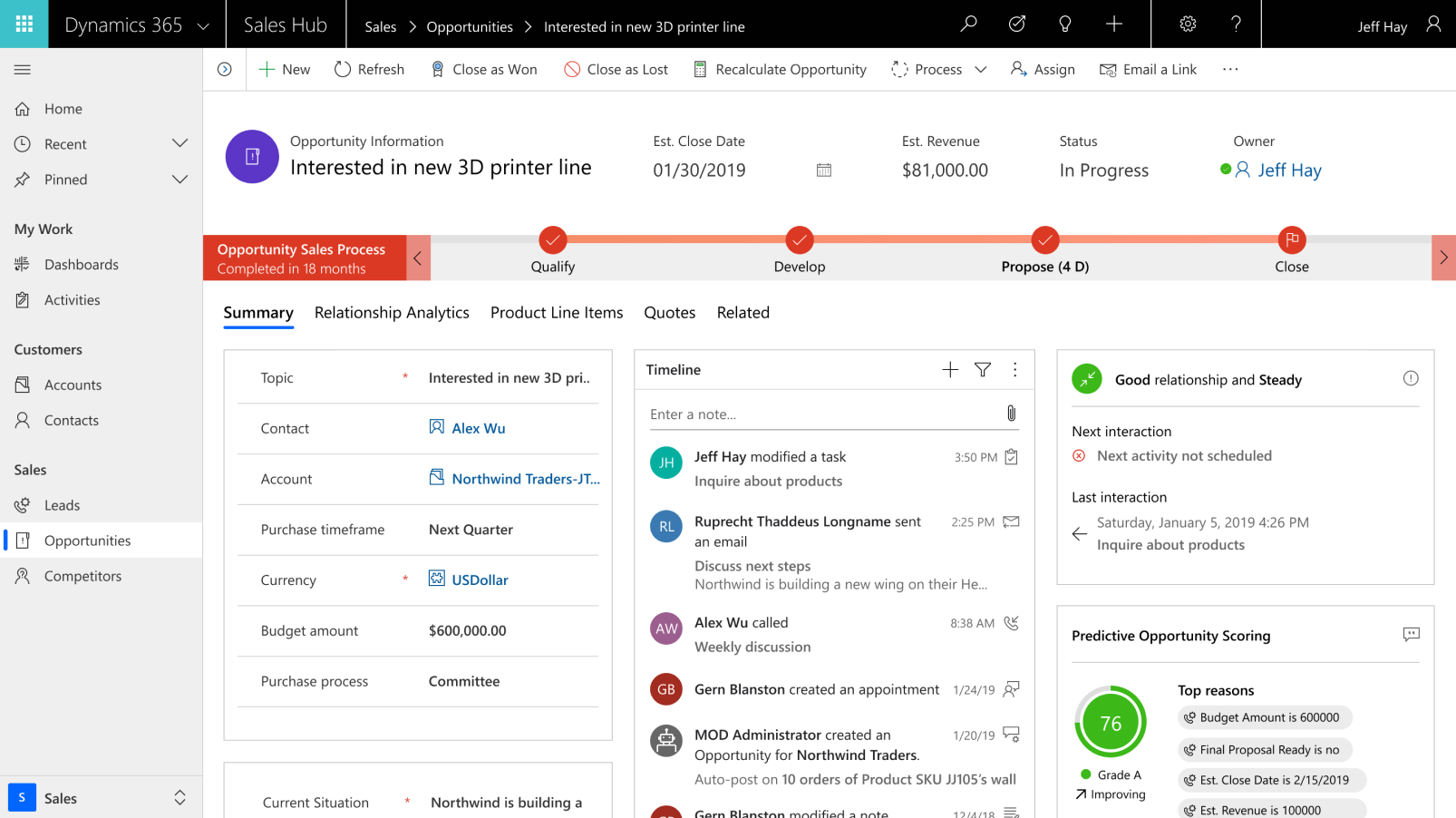- Dec 31, 2020 There may be certifications and prerequisites related to 'Exam MB-400: Microsoft Power Apps + Dynamics 365 Developer' Microsoft Certified: Power Apps + Dynamics 365 Developer Associate Developers who work with Microsoft Power Apps and Dynamics 365 are responsible for designing, developing, securing, and extending a Dynamics 365 implementation.
- The pricing engine uses complex rules to determine the best price for a given quotation or order. When you use dual-write, you use either static pricing or the pricing engine from Dynamics 365 Supply Chain Management on the Quote and Order pages in Dynamics 365 Sales. Use the pricing engine from Supply Chain Management in Sales.
- Microsoft Dynamics 365 Pricing Calculator
- Microsoft Dynamics 365 Nonprofit Pricing
- Microsoft Dynamics 365 Wikipedia
- Microsoft Dynamics 365 Erp
Microsoft Dynamics 365 Pricing Calculator
-->Dynamics 365 Customer Engagement (on-premises) uses the ProductPriceLevel.PricingMethodCode attribute to determine prices. The value of this attribute affects:

Microsoft Dynamics 365 Nonprofit Pricing
Access Our Microsoft Dynamics 365 CRM Pricing Calculator Your cost for Dynamics 365 CRM will depend on the size of your sales team and the licenses you choose to purchase. On average, our customers spend about $5,000 to $10,000 on their annual subscription, while implementation typically costs $15,000. Microsoft 365 is a subscription that includes the most collaborative, up-to-date features in one seamless, integrated experience. Microsoft 365 includes the robust Office desktop apps that you’re familiar with, like Word, PowerPoint, and Excel.
How the price for the product is determined for each unit of measure that is defined for that product.
What attributes are required when you create or update a product price level and its associated product.
You can also use custom pricing for products instead of using the Dynamics 365 system pricing. More information: Use custom pricing for products
The following table lists the formulas that are used for each value and the attributes that are required by each value.
| Drop-down list value and equivalent pricing method value | Description and required attributes |
|---|---|
| Currency Amount CurrencyAmount = 1 | The price is specified for each unit of measure for each product. price = amount For each unit of measure for each product, use the ProductPriceLevel.Amount attribute. Note: The ProductPriceLevel.Amount attribute isn’t platform required if you’re not using the pricing methods provided by Dynamics 365 for Customer Engagement. However, if you use the Currency Amount pricing method to determine a price, this attribute is platform required and you must specify a value for this attribute. |
| Percent of List PercentListPrice = 2 | The price is calculated based on the manufacturer's or distributor's list price. calculated price = list price x percentage For each unit of measure for each product, you must enter data for the following attributes: - Product.Price attribute. This is the List Price in the Product form.- ProductPriceLevel.Percentage attribute. This is the desired percentage of the list price.- ProductPriceLevel.RoundingPolicyCode attribute. This is the policy for rounding the price list. |
| Percent Markup - Current Cost MarkupCurrentCost = 3 | The price is calculated as a percentage of your current cost for the item. calculated price = current cost x 100% + percentage For each unit of measure for each product, you must enter data for the following attributes: - Product.CurrentCost attribute. You must update this cost every time that you receive a shipment of the item.- ProductPriceLevel.Percentage attribute. This is the percent markup.- ProductPriceLevel.RoundingPolicyCode attribute. |
| Percent Margin - Current Cost MarginCurrentCost =4 | The price is based on the profit percentage you want to achieve and your current cost for the item. calculated price = current cost + [(current cost x percentage)/ (100% - percentage)] For each unit of measure for each product, you must enter data for the following attributes: - Product.StandardCost attribute. You must update this cost every time when you receive a shipment of the item.- ProductPriceLevel.Percentage attribute. This is the profit percentage you want to achieve.- ProductPriceLevel.RoundingPolicyCode attribute. |
| Percent Markup - Standard Cost MarkupStandardCost = 5 | The price is calculated as a percentage of the standard cost of the item. calculated price = standard cost x 100% + percentage Because the standard cost is updated periodically, the standard cost amount in this equation is an average and will not always be the same as the amount you paid most recently for the item. For each unit of measure for each product, you must enter data for the following attributes: - Product.StandardCost attribute. Every time that you update the standard cost, the price changes.- ProductPriceLevel.Percentage attribute. This is the percent markup.- ProductPriceLevel.RoundingPolicyCode attribute. |
| Percent Margin - Standard Cost MarginStandardCost = 6 | The price is based on the profit percentage you want to achieve and the standard cost of the item. calculated price = standard cost + [(standard cost x percentage)/(100% - percentage)] Because the standard cost is updated periodically, the standard cost amount in this equation is an average and will not always be the same as the amount you paid most recently for the item. For each unit of measure for each product, you must enter data for the following attributes: - Product.StandardCost attribute. Every time that you update the standard cost, the price changes.- ProductPriceLevel.Percentage attribute. This is the profit percentage you want to achieve.- ProductPriceLevel.RoundingPolicyCode attribute. |
To set the values for the ProductPriceLevel.PricingMethodCode attribute and the other product price level entity attributes, use the IOrganizationService.Update method, passing an instance of the ProductPriceLevel class. To set the values for the product attributes, use the methods in the Product class.
See Also
Microsoft Dynamics 365 Wikipedia
ProductPriceLevel Entity
Product Entity
Product Catalog Entities
Note
Can you tell us about your documentation language preferences? Take a short survey.
The survey will take about seven minutes. Ris informatique laptops & desktops driver download for windows 10. No personal data is collected (privacy statement).
-->Dynamics 365 Customer Engagement (on-premises) uses the ProductPriceLevel.PricingMethodCode attribute to determine prices. The value of this attribute affects:

How the price for the product is determined for each unit of measure that is defined for that product.
What attributes are required when you create or update a product price level and its associated product.
You can also use custom pricing for products instead of using the Dynamics 365 system pricing. More information: Use custom pricing for products
The following table lists the formulas that are used for each value and the attributes that are required by each value.
| Drop-down list value and equivalent pricing method value | Description and required attributes |
|---|---|
| Currency Amount CurrencyAmount = 1 | The price is specified for each unit of measure for each product. price = amount For each unit of measure for each product, use the ProductPriceLevel.Amount attribute. Note: The ProductPriceLevel.Amount attribute isn’t platform required if you’re not using the pricing methods provided by Dynamics 365 for Customer Engagement. However, if you use the Currency Amount pricing method to determine a price, this attribute is platform required and you must specify a value for this attribute. |
| Percent of List PercentListPrice = 2 | The price is calculated based on the manufacturer's or distributor's list price. calculated price = list price x percentage For each unit of measure for each product, you must enter data for the following attributes: - Product.Price attribute. This is the List Price in the Product form.- ProductPriceLevel.Percentage attribute. This is the desired percentage of the list price.- ProductPriceLevel.RoundingPolicyCode attribute. This is the policy for rounding the price list. |
| Percent Markup - Current Cost MarkupCurrentCost = 3 | The price is calculated as a percentage of your current cost for the item. calculated price = current cost x 100% + percentage For each unit of measure for each product, you must enter data for the following attributes: - Product.CurrentCost attribute. You must update this cost every time that you receive a shipment of the item.- ProductPriceLevel.Percentage attribute. This is the percent markup.- ProductPriceLevel.RoundingPolicyCode attribute. |
| Percent Margin - Current Cost MarginCurrentCost =4 | The price is based on the profit percentage you want to achieve and your current cost for the item. calculated price = current cost + [(current cost x percentage)/ (100% - percentage)] For each unit of measure for each product, you must enter data for the following attributes: - Product.StandardCost attribute. You must update this cost every time when you receive a shipment of the item.- ProductPriceLevel.Percentage attribute. This is the profit percentage you want to achieve.- ProductPriceLevel.RoundingPolicyCode attribute. |
| Percent Markup - Standard Cost MarkupStandardCost = 5 | The price is calculated as a percentage of the standard cost of the item. calculated price = standard cost x 100% + percentage Because the standard cost is updated periodically, the standard cost amount in this equation is an average and will not always be the same as the amount you paid most recently for the item. For each unit of measure for each product, you must enter data for the following attributes: - Product.StandardCost attribute. Every time that you update the standard cost, the price changes.- ProductPriceLevel.Percentage attribute. This is the percent markup.- ProductPriceLevel.RoundingPolicyCode attribute. |
| Percent Margin - Standard Cost MarginStandardCost = 6 | The price is based on the profit percentage you want to achieve and the standard cost of the item. calculated price = standard cost + [(standard cost x percentage)/(100% - percentage)] Because the standard cost is updated periodically, the standard cost amount in this equation is an average and will not always be the same as the amount you paid most recently for the item. For each unit of measure for each product, you must enter data for the following attributes: - Product.StandardCost attribute. Every time that you update the standard cost, the price changes.- ProductPriceLevel.Percentage attribute. This is the profit percentage you want to achieve.- ProductPriceLevel.RoundingPolicyCode attribute. |
To set the values for the ProductPriceLevel.PricingMethodCode attribute and the other product price level entity attributes, use the IOrganizationService.Update method, passing an instance of the ProductPriceLevel class. To set the values for the product attributes, use the methods in the Product class.
See Also

Microsoft Dynamics 365 Erp
ProductPriceLevel Entity
Product Entity
Product Catalog Entities
Note
Can you tell us about your documentation language preferences? Take a short survey.
The survey will take about seven minutes. No personal data is collected (privacy statement).
